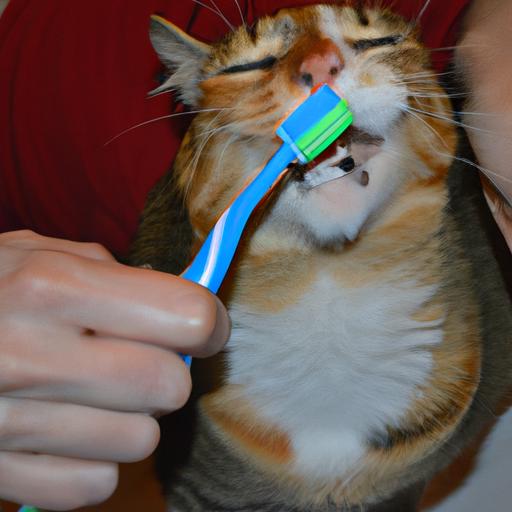
Teaching Cats to Enjoy Toothbrushing: A Guide to Optimal Oral Health
Discover the ultimate guide to teaching cats to enjoy toothbrushing. Improve their oral health and ensure a happy, healthy smile. Start today!
Introduction
When it comes to the health and well-being of our feline friends, proper oral hygiene is often overlooked. However, just like humans, cats can suffer from dental issues that can lead to pain, discomfort, and even more serious health problems. That’s why teaching cats to enjoy toothbrushing is essential for their overall health. In this comprehensive guide, we will explore the steps to successfully introduce toothbrushing to your cat, address common concerns, and provide valuable tips for maintaining your cat’s oral health.

Steps to Teach Cats to Enjoy Toothbrushing
1. Understanding your cat’s behavior and preferences
Cats are unique individuals with different temperaments and preferences. Before introducing toothbrushing, it’s crucial to observe your cat’s behavior and determine the best approach. Some cats may be naturally more receptive to new experiences, while others may require a gradual and patient introduction. By understanding your cat’s behavior and preferences, you can tailor your approach to ensure a positive toothbrushing experience.
2. Introducing toothbrushing gradually and positively
The key to successfully teaching cats to enjoy toothbrushing is to make it a positive and gradual experience. Start by introducing your cat to the toothbrush and toothpaste in a non-threatening manner. Allow your cat to sniff and explore these new items, rewarding them with treats and praise. Gradually progress to touching the toothbrush to their gums, always providing positive reinforcement. Patience and consistency are vital during this process, ensuring your cat associates toothbrushing with positive experiences.
3. Selecting the right toothbrush and toothpaste for your cat
Choosing the appropriate toothbrush and toothpaste is crucial for a successful toothbrushing routine. Opt for a toothbrush specifically designed for cats, as their bristles are softer and more gentle on their delicate gums. Additionally, select a toothpaste formulated for cats, avoiding human toothpaste as it can be harmful when ingested. Experiment with different flavors to find the one that your cat prefers, making toothbrushing a more enjoyable experience for them.
4. Establishing a toothbrushing routine
Consistency is key when it comes to teaching cats to enjoy toothbrushing. Establishing a regular toothbrushing routine helps your cat become familiar with the process and gradually accept it as part of their daily routine. Start with short brushing sessions, gradually increasing the duration as your cat becomes more comfortable. Aim to brush your cat’s teeth at least two to three times a week, but consult with your veterinarian for personalized recommendations based on your cat’s dental health.
Frequently Asked Questions (FAQ) about Teaching Cats to Enjoy Toothbrushing
Can all cats be trained to enjoy toothbrushing?
Yes, with patience and proper training techniques, most cats can be trained to tolerate and even enjoy toothbrushing. However, it’s important to remember that each cat is unique, and their response to toothbrushing may vary. Consistency and positive reinforcement are key factors in successfully training your cat.
How often should I brush my cat’s teeth?
Ideally, you should aim to brush your cat’s teeth two to three times a week. However, some cats may require more frequent brushing, especially if they are prone to dental issues. Regular dental check-ups with your veterinarian will help determine the optimal brushing frequency for your cat’s specific needs.
What if my cat refuses to let me brush its teeth?
If your cat resists toothbrushing initially, don’t worry. Start by gently introducing the toothbrush and toothpaste, allowing your cat to become comfortable with these items. Gradually progress to touching their gums with the toothbrush and seek to associate positive experiences with toothbrushing, such as treats and praise. Patience, consistency, and positive reinforcement will eventually help your cat accept toothbrushing as part of their routine.
Are there any alternative methods to toothbrushing for cats?
While toothbrushing is the most effective method for maintaining your cat’s oral health, there are alternative options available. Dental wipes, dental gels, and dental treats can help reduce plaque and tartar buildup to some extent. However, these alternatives are not as effective as brushing and should be used in conjunction with regular toothbrushing for optimal oral health.
Conclusion
Teaching cats to enjoy toothbrushing is an essential step in ensuring their optimal oral health. By understanding their behavior, introducing toothbrushing gradually, and using the right tools and techniques, you can establish a positive toothbrushing routine for your feline companion. Remember, consistency, patience, and positive reinforcement are key to success. Prioritize your cat’s oral health, and together, you can pave the way for a healthier and happier life for your beloved furry friend.
So, why wait? Start teaching your cat to enjoy toothbrushing today and embark on a journey towards maintaining their bright and healthy smile!
*[SEO]: Search Engine Optimization























